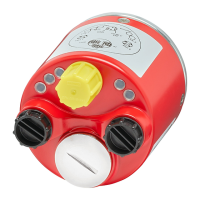Rockwell Automation Publication 843ES-UM001A-EN-P - February 2020 43
Add Device to an EtherNet/IP Network Chapter 4
Network Topologies
The 843ES CIP Safety encoder supports linear, ring, and star network
topologies.
A linear topology is a collection of devices that are daisy chained together.
Device Level Ring (DLR) supports a ring topology. As defined by the Open
DeviceNet Vendor Association (ODVA), Device Level Ring is an EtherNet/IP
protocol. DLR provides a means to detect, manage, and recover from single faults
in a ring-based network.
The star topology consists of a number of modules that are connected to a central
switch. Modules can be added or removed without affecting the rest of the
network.
For more information on the supported EtherNet/IP network topologies and
other EtherNet/IP features, see publication ENET-UM006
.
Protected Modes
The 843ES CIP Safety encoder supports both implicit and explicit protected
modes.
Implicit Protected Mode
Implicit Protected mode is a security enhancement that is automatically triggered
as soon as one of the following occur:
• The device bridges I/O connections.
• The device is a target of I/O connections.
Implicit Protected mode is a state where the device is operational, but has
implemented defenses against disruptive changes that would take the product out
of service for the process.
This security enhancement occurs on the I/O module level and helps prevent
unauthorized configuration changes that can affect system behavior and cause
unintended and unforeseen changes.
Enable and Disable Implicit Protected Mode
Implicit Protected mode is enabled on the device as soon as I/O connections are
established through the device. Implicit Protected mode is enabled on the device
as soon as all I/O connections through the device are stopped.

